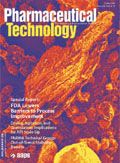Time to Go to School
Growth is critical to a strong company, and not only because it generates economies of scale.
The growth of offshore sourcing alternatives has become a staple of this column, reflecting the fact that major pharmaceutical companies increasingly are attracted to material suppliers and service providers in India, China, and other low-cost locales. The pharmaceutical industry is experiencing this trend much later than other industrial sectors, allowing pharmaceutical suppliers the opportunity to "go to school" and learn from other industries.

Jim Miller
In a recent article in The New York Times (Sept. 4, 2005), writer Louis Uchitelle profiled several companies that have been successful in the face of low-cost foreign competition, including Harley-Davidson and machine-tool maker Haas Automation. The stories of these companies focus on constant attention to managing costs, differentiating products, and understanding what is valuable to their customers. The key elements to their success can be summarized as:
- strict management of labor costs;
- value-oriented product and service development;
- taking advantage of regulatory barriers;
- striving for growth.
Pharmaceutical vendors must think about how to apply these tactics to their company's structure.
Labor costs. Successful competitors work continuously to reduce the labor portion of their cost structure. Their rationale is simple: the less labor in a product, the less susceptible they are to low-wage competition.
Labor costs have two elements: the price of labor (labor rates and fringe-benefit costs) and the quantity of labor used. US companies have learned that their real advantage comes from managing the quantity of labor, by automating processes wherever possible, continuously improving work processes, and loosening restrictive work rules.
Pharmaceutical services providers traditionally have not focused on cost management as closely as companies in other industries, so they have tremendous opportunities to drive labor costs down. Some initiatives have made significant headway in the industry:
- The growing use of disposables in biomanufacturing can reduce the staff hours necessary to set up, clean, and validate manufacturing equipment and suites.
- The use of preprocessed materials such as prewashed and sterilized components in sterile injectable manufacturing reduces the number of manufacturing steps and the associated labor requirements.
- Web-based project management and logistics interfaces, which have become standard in the clinical supplies sector, reduce demands on customer-service resources while giving clients a greater sense of control over their development projects.
- Implementing Six Sigma continuous improvement initiatives usually delivers substantial cost savings.
- Adopting process analytical technologies (PAT) reduces the operator and technician resources required for sampling and testing batches and should reduce the amount of re-work.
Value-oriented products and services. Successful companies continuously improve their products and services to stay ahead of the competition. By adding value-enhancing features to their products and services, pharmaceutical suppliers can continue to count on value-based pricing to maintain their position in the market.
Input and equipment suppliers can improve customer relationships by keeping extra inventories of materials and spare parts on hand for rapid delivery, because customers will pay a premium to avoid costly shutdowns or shipment delays. Similarly, manufacturers and CROs that maintain excess capacity to meet changing client schedules or product demand can command a premium price. Service providers also can offer additional capabilities that reduce their clients' total costs (e.g., materials-vendor qualification services).
Regulations. Trade barriers often provide protection from offshore competitors, allowing successful companies to re-establish their competitive positions. According to Uchitelle, Harley-Davidson benefited from import regulations that restricted the import of heavy motorcycles. Such barriers, however, are increasingly difficult to erect in this era of free trade (NAFTA, World Trade Organization), Uchitelle notes.
In a similar way, North American and European manufacturers historically have taken advantage of the difficulty and cost of complying with good manufacturing practices (GMP). That advantage is eroding, however, because Indian and Chinese suppliers have upgraded their compliance standards to meet Western requirements, and both FDA and USP have established major outposts in India.
Still, GMPs are a moving target, with FDA and sponsors continually raising standards as companies push the boundaries of best practices. Continuously improving compliance, with the help of new technologies such as sophisticated manufacturing execution systems and PAT (which also reduce labor requirements), can establish leadership positions that keep offshore competitors playing catch-up.
Growth. Growth is critical to a strong company, and not only because it generates economies of scale. Uchitelle notes that successful labor-saving programs often involve trade-offs negotiated between workers and management such as management agreeing not to lay off employees in exchange for employees contributing labor-saving ideas. If workers can't be laid off, they must be absorbed by growth.
In today's pharmaceutical industry, there are plenty of growth opportunities in the rejuvenated product pipeline and consequent increased use of outsourced services. Because the industry is still fragmented, additional growth will come from contractors and suppliers grabbing market share from competitors.
Although US-based companies in other industries were caught off-guard by offshore competition in the 1970s, 1980s, and 1990s, pharmaceutical suppliers have no excuse for not responding to their new industry dynamics. There are examples of how to respond—and of what happens when you don't—all around. Pharmaceutical vendors should be using some of the profits accruing in these robust times to make sure that they maintain their long-term competitiveness.
Jim Miller is president of PharmSource Information Services, Inc., and publisher of Bio/Pharmaceutical Outsourcing Report, tel. 703.383.4903, fax 703.383.4905, info@pharmsource.comwww.pharmsource.com.

WMFTS’ BioPure to Showcase Single-Use Bioclamp with Refined Manufacturing at INTERPHEX 2025
April 1st 2025With advanced manufacturing, BioPure’s BioClamp connector is manufactured to be 13% lighter than the previous model, resulting in a 26% reduction in carbon dioxide emissions across the full lifecycle of the product.